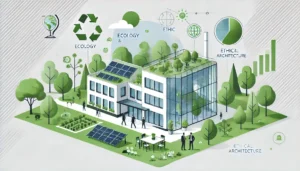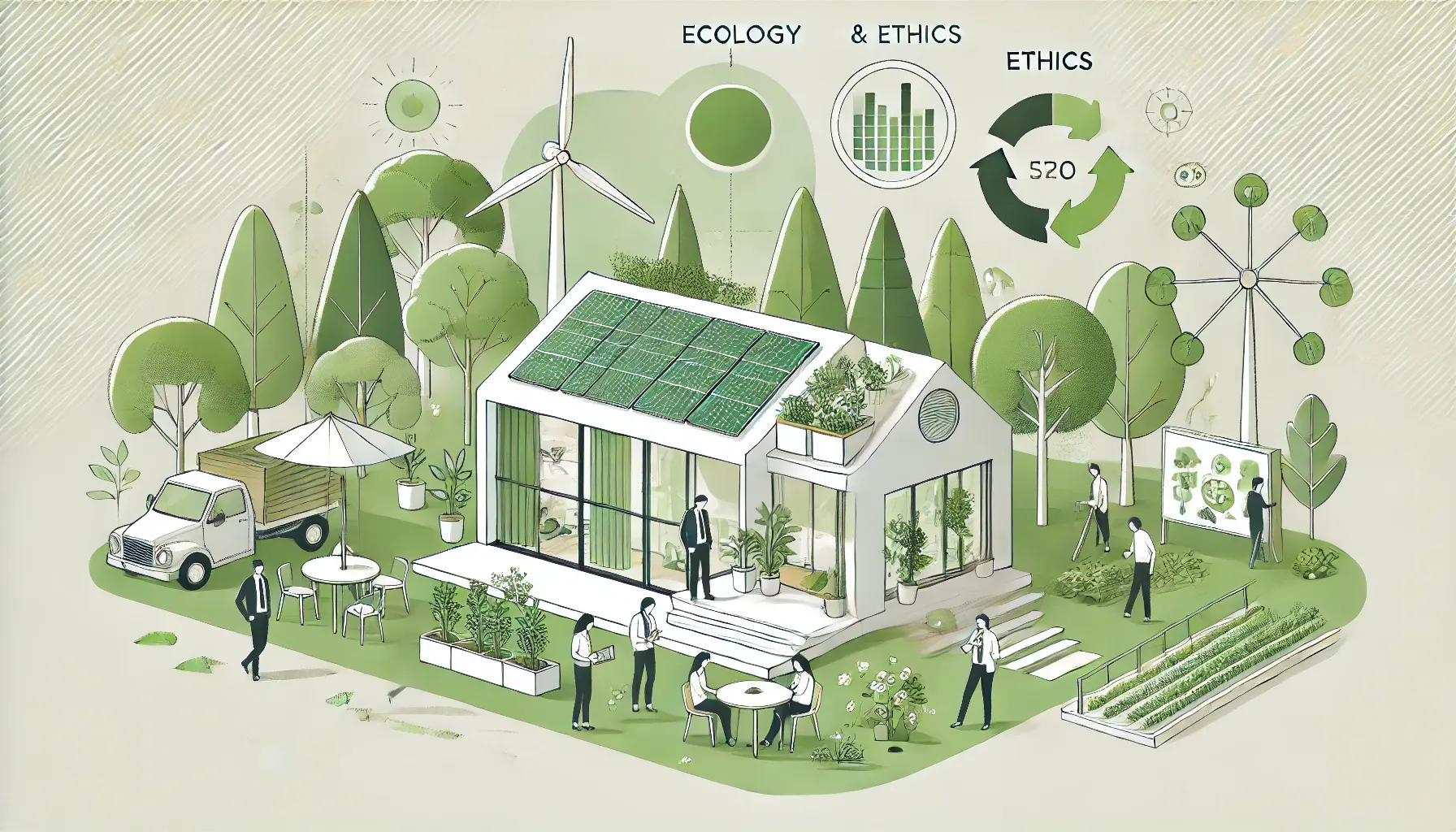Introduction
At a time when concerns about the environment pervade all global discussions, this course content on Ecology and Ethics as parts of design have greater relevance than in many years. This convergence, which is sometimes referred to as “sustainable design” or “green architecture,” endeavors to contribute the built environment into balance with nature. This article goes well beyond the practices of principles and philosophies that drive this movement, insisting on all to hold ecologically responsible design views.

Principles of Sustainable Design
Truly sustainable design stems from a mindset of sustainability for the environment- as well as an embodied experience and consideration into account in material selection, environmental control or planning preference. It includes a variety of practices designed to determine and eliminate the negative environmental impacts, reduce energy use in all stages through better build quality; and create healthier living conditions. The principles of sustainable design are better described as follows:
Resource Efficient – Acting with materials, water, and energy. It also reduces waste and environmental degradation through resource efficiency.
The complete life cycle of a building or product-from the extraction of raw materials to deflection and beyond-is considered when designing sustainably.
Human Health & Well-being: Supports human health, comfort, and well-being of occupants which also covers indoor air quality, natural light, and ergonomics.
Environmental Impact: Designs should be chosen to lessen the impact on the environment, limiting pollution, habitat destruction, and carbon emissions.
The Moral Dimension of Design
Over time, ethics in design have extended beyond the traditional sustainability lens of environmental stewardship to encompassing a larger social and cultural responsibility. At its core, ethical design acknowledges the responsibility of a designer to shape not only physical spaces, but social interactions and-important for our purposes here-community dynamics.
Unique Ethical Considerations
Equity and Accessibility: Design must accommodate the demographic diversity of our planet (yes, even you billionaires) by ensuring that everyone has access to it regardless of physical disability, socioeconomic status, or cultural background.
Design to Reflect Cultural Integrity and Respect: Design should be in sensitivity with the cultural heritage/history of where it is located, reflecting community identity.
Transparency and Honesty: Ethical design should be available for discussion with stakeholders, exposing the project benefits as well as its faults.
The Top Strategies in Sustainable Design and Architecture
- Passive Design Strategies
Sustainable architecture is dependent on passive design strategies. The most influential and powerful techniques employed to preserve comfortable building conditions where the climate is harsh include natural ventilation, surface cooling utilizing photovoltaic collectors etc. Passive design measures are grounded in a few key strategies including:
Orientation & Layout: Placement of buildings to the North/South site; making the most out of natural light and air. Windows that face south in the Northern Hemisphere, by contrast, receive a lot of sunlight during winter months.
Thermal Mass – Materials such as concrete or stone that absorb heat during the day and release it at night, helping to stabilize indoor temperatures.
Insulation – Good insulation for walls, roofs and floors helps prevent heat loss in the winter or gain in summer(helps to improve energy efficiency).
Green architecture always integrates renewable energy sources. Alternatively solar panels, wind turbines and geothermal systems offer an environmentally safe solution to fossil fuels. These clean technologies also reduce emissions but are many times used to increase our energy independence.
The biggest one – the sun! Solar Power: The direct conversion of sunlight into electricity, this is done using Photovoltaic (PV) panels. Sun Rays – Resort are facilities where H20 or air is heated a-utilizing the solar thermal…
Wind Energy: Small wind turbines that can be designed in a suitable part of the building generating electricity.
Geothermal Systems: These systems use the steady temperatures below ground to heat and cool properties with pop lessening traditional dependence on HVAC techniques.
- Green Roofs and Walls
To the rescue: Green roofs and walls, ingenious designs which insert healthy nature into cities. Such living structures which provide many ecological benefits such as –
In order to save homes from heating and cooling costs the green layers inside or on top of roofs, walls etc will be used as an insulation.
Water For Vegetative Roofing Systems: Reusing stormwater in vegetative roofing frameworks makes it perfect as a piece of norm Neighborhood expert imperatives just for takeoff levels Water Control Grants. Saves money on their water supplies.
Air Quality: Plants absorb pollutants and carbon dioxide, which helps to purify the air in urban areas.
- Sustainable Materials
Materials Determination is Convenient in Sustainable Design MORE: Sustainable materials MORE sustainable design trends – Designers & Architects go GREEN (more than ever) Examples include:
Bamboo – A rapidly, renewable species in flooring and cabinetry (Lee Wood Works structural component above).
The use of recycled steel and concrete: The utilization of recycled items lessens the demand for new raw materials, which require a lot of energy in production.
Low-VOC Paints and Finishes: Volatile organic compounds (VOC) are emitted as gas from certain solids or liquids. Low-VOC products help with indoor air quality and human health.
- Water Conservation
Addressing water scarcity is a global challenge and sustainable design has to ensure that practices such as using water resources judiciously, managing the wastewater properly are aimed at tackling this very issue. Strategies include:
Low Flow Fixtures: Devices such as faucets, showerheads, and toilets that are specifically designed to consume less water without hampering performance.
Rainwater Harvesting: Rainwater catchment and reuse systems for non-potable use, such as landscaping irrigation or toilet flushing.
Greywater is the used water from sinks, showers, and laundry (not including toilet wastes). Greywater Systems: treating grey waters for reuse across landscapes.
Case Studies in Sustainable Architecture
The Edge, Amsterdam
Amsterdam The Edge is arguably the greenest building of its kind in the world. The office building includes several sustainable features –
ENERGY: On an energy performance basis, the building is designed to achieve 70% greater efficiency compared to similarly used office buildings. This is done through the use of intelligent lighting systems, solar power, and good insulation.
Clip of Water Management: Rainwater harvesting for flushing toilets and watering plants.
Smart technology: A deep network of sensors ensures maximum energy usage efficiency and occupant comfort-from light-level control to occupancy monitoring-all defining Hijauan Kiara as a place for living.
Bosco Verticale, Milan
Milan’s Bosco Verticale, or Vertical Forest, for example, is a great way to bring nature into the city. The residential development includes two towers containing more than 900 trees as well as several thousands of shrubs and plants. Benefits include:
Ecological: The landscaping houses birds and insects, adding to the urban biodiversity.
Each plant inside will help regulate overall temperature control for the buildings, which means less air conditioning during summertime and lower heating demands over winter.
Air filtration: all the greenery acts as a filter for dust and pollution in the air, leading to a better healthy life for residents.
A Guiding Hand to Sustainable Design- Technology
Sustainable design and architecture: Technology innovations Sustainable sensibility: Technology is making it easier to do the right thing, from smart building systems to space-age materials.
— Building Information Modeling (BIM)
BIM or Building Information Modeling is a digital representation of the physical and functional characteristics of a building. This helps architectural and engineering experts understand the performance of a building based on simulations before it is built. Benefits include:
Better Cooperation: BIM strengthens collaboration with all parties which allows ensuring the sustainability goals right through the design and construction phase.
Energy Simulation: It is possible to run energy simulations using BIM tools, which support the design process so designers could be able to perform their work and decrease carbon footprints of a building.
Lifecycle Management: This feature of BIM can help manage lifecycle operations from designing & construction to operation & maintenance, supporting green practices in every phase.
Smart Building Systems
Smart systems in buildings are based on the use of sensors, data analytics, and automation to drive improvements across building performance metrics. Examples include:
Energy Management Systems: These systems watch and assess the use of energy to make sure it is used sustainably, in both production and consumption.
Occupancy Sensors: Space occupancy triggers sensors to switch lights on and off, as well as turn the heating or air conditioning up/down (as applicable), reducing unnecessary energy consumption.
One example of how we benefit from using AI to create circular economies is in the way that these smart systems can predict when maintenance should be done and thus preventing costly breakdowns, and damages to environments etc. by just waiting for something bad to happen as today’s scheduled or mileage-based maintenance does.
Advanced Materials
Advances in material science are opening up pathways for sustainable design. Advanced materials are for example:
Aerogels – The type of super lightweight insulating materials which can aid in energy conservation.
Phase-Change Materials – These absorb heat (or release it when the stored energy is released during a physical change of state) and stabilize building interior temperatures.
This means a concrete that self-repairs its cracks, to extend the life of structures and reduce repair/replacement costs.
Sustainable Design and Architecture in the Future
As a direct result of the global population eventually expanding and moving to metropolitan areas, sustainable design/architecture remains in demand. Some stuff is still to come in the near future:
Regenerative Design
Sustainability is synonymous with conserving resources, so Regenerative design approaches restoration and the enrichment of ecosystems as key to integrated green building. It reaches far beyond traditional goodwill initiatives to focus on generating net-positive impacts lastingly, such as:
Restorative Ecosystems: Building and landscape design is important in the creation of plants that can restore natural habitats, biodiversity.
Buildings whose overproduction of energy is fed back into the grid (Positive Energy).
Circular Economy – Designing for disassembly and reuse, making sure that after their service life materials can be recycled or repurposed in general.
Biophilic Design
Biophilic design focuses on establishing a connection between humans and nature. The pattern looks to blend naturalized elements with the manmade urban environment in an effort towards health and well-being. Key principles include:
Natural Daylight: To improve daylighting, natural light is manipulated to optimize a healthy and welcoming environment.
As nature materials: material such as wood stone, and leaves can create feelings of empathy with the surroundings.
Outdoor Spaces: Creating usable, attractive outdoor spaces for respite and recreation.
Climate-Responsive Design
Climate-responsive design: designs buildings that fit into the local climate, using energy more efficiently and making better use of geoclimate. Strategies include:
Energy Efficiency Feature 2: Adaptive FacadesAdaptive facades can modify themselves in accordance with the changing atmospheric conditions to optimize its performance and interior thermal comfort.
Building for Natural Ventilation – Encouraging good cross-ventilation to reduce the demand for mechanical ventilation & aircon.
Resiliency: Making buildings resist the impacts of extreme weather events and a changing climate.
Conclusion
More than just a trend, the Green Revolution in design and architecture is as urgent as ever considering our blooming planet. With the integration of sustainable principles, ethical considerations, and creative technologies, architects & designers are addressing a general direction that not only serves as eco-friendly to preserve resources rather than depleting them but also makes communities more liveable for all its inhabitants. Designers, policymakers, and communities around the world must continue collaborating to move towards a sustainable and more ethical built environment. This promise going forward will continue to be fueled by the bio-regional air the way in which nature bridges schema and a future where built environment with natural one and are nested as companion.
